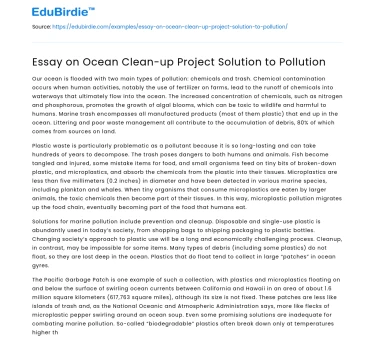Our ocean is flooded with two main types of pollution: chemicals and trash. Chemical contamination occurs when human activities, notably the use of fertilizer on farms, lead to the runoff of chemicals into waterways that ultimately flow into the ocean. The increased concentration of chemicals, such as nitrogen and phosphorous, promotes the growth of algal blooms, which can be toxic to wildlife and harmful to humans. Marine trash encompasses all manufactured products (most of them plastic) that end up in the ocean. Littering and poor waste management all contribute to the accumulation of debris, 80% of which comes from sources on land.
Plastic waste is particularly problematic as a pollutant because it is so long-lasting and can take hundreds of years to decompose. The trash poses dangers to both humans and animals. Fish become tangled and injured, some mistake items for food, and small organisms feed on tiny bits of broken-down plastic, and microplastics, and absorb the chemicals from the plastic into their tissues. Microplastics are less than five millimeters (0.2 inches) in diameter and have been detected in various marine species, including plankton and whales. When tiny organisms that consume microplastics are eaten by larger animals, the toxic chemicals then become part of their tissues. In this way, microplastic pollution migrates up the food chain, eventually becoming part of the food that humans eat.
Save your time!
We can take care of your essay
- Proper editing and formatting
- Free revision, title page, and bibliography
- Flexible prices and money-back guarantee
Solutions for marine pollution include prevention and cleanup. Disposable and single-use plastic is abundantly used in today’s society, from shopping bags to shipping packaging to plastic bottles. Changing society’s approach to plastic use will be a long and economically challenging process. Cleanup, in contrast, may be impossible for some items. Many types of debris (including some plastics) do not float, so they are lost deep in the ocean. Plastics that do float tend to collect in large “patches” in ocean gyres.
The Pacific Garbage Patch is one example of such a collection, with plastics and microplastics floating on and below the surface of swirling ocean currents between California and Hawaii in an area of about 1.6 million square kilometers (617,763 square miles), although its size is not fixed. These patches are less like islands of trash and, as the National Oceanic and Atmospheric Administration says, more like flecks of microplastic pepper swirling around an ocean soup. Even some promising solutions are inadequate for combating marine pollution. So-called “biodegradable” plastics often break down only at temperatures higher than will ever be reached in the ocean.
Did you like this example?
Make sure you submit a unique essay
Our writers will provide you with an essay sample written from scratch: any topic, any deadline, any instructions.
Cite this paper
-
APA
-
MLA
-
Harvard
-
Vancouver
Essay on Ocean Clean-up Project Solution to Pollution.
(2023, October 27). Edubirdie. Retrieved December 22, 2024, from https://edubirdie.com/examples/essay-on-ocean-clean-up-project-solution-to-pollution/
“Essay on Ocean Clean-up Project Solution to Pollution.” Edubirdie, 27 Oct. 2023, edubirdie.com/examples/essay-on-ocean-clean-up-project-solution-to-pollution/
Essay on Ocean Clean-up Project Solution to Pollution. [online].
Available at: <https://edubirdie.com/examples/essay-on-ocean-clean-up-project-solution-to-pollution/> [Accessed 22 Dec. 2024].
Essay on Ocean Clean-up Project Solution to Pollution [Internet]. Edubirdie.
2023 Oct 27 [cited 2024 Dec 22].
Available from: https://edubirdie.com/examples/essay-on-ocean-clean-up-project-solution-to-pollution/
copy






 Stuck on your essay?
Stuck on your essay?

